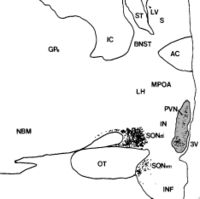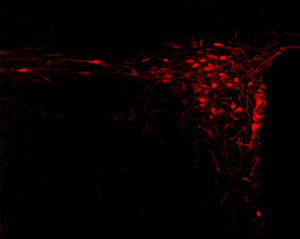Paraventricular nucleus: Difference between revisions
imported>Subpagination Bot m (Add {{subpages}} and remove any categories (details)) |
imported>Gareth Leng |
||
| Line 14: | Line 14: | ||
The parvocellular neurosecretory neurons of the PVN project axons to the median eminence, at the base of the brain. At the median eminence, the neurosecretory nerve terminals release peptides into the blood vessels of the hypothalamo-pituitary portal system. These vessels carry the peptides to the [[anterior pituitary]] gland, where they regulate hormone secretion into the systemic circulation. The parvocellular neurosecretory cells include: | The parvocellular neurosecretory neurons of the PVN project axons to the median eminence, at the base of the brain. At the median eminence, the neurosecretory nerve terminals release peptides into the blood vessels of the hypothalamo-pituitary portal system. These vessels carry the peptides to the [[anterior pituitary]] gland, where they regulate hormone secretion into the systemic circulation. The parvocellular neurosecretory cells include: | ||
* cells that make [[ | * neuroendocrine cells that make [[corticotrophin releasing hormone]] (CRH), which regulates [[adrenocorticotropic hormone]] (ACTH) secretion from the [[anterior pituitary gland]], | ||
* cells that make [[vasopressin]]: vasopressin released from these neurons also regulates ACTH secretion; vasopressin and CRH act synergistically to stimulate ACTH secretion. | * neuroendocrine cells that make [[vasopressin]]: vasopressin released from these neurons also regulates ACTH secretion; vasopressin and CRH act synergistically to stimulate ACTH secretion. | ||
* cells that make [[ | * neuroendocrine cells that make [[thyrotrophin releasing hormone]] (TRH), which regulates [[TSH]] secretion. | ||
==Centrally-projecting neurons== | ==Centrally-projecting neurons== | ||
Revision as of 12:48, 6 January 2011

The paraventricular nucleus (PVN, PVH) is an aggregation of neurons in the hypothalamus, adjacent to the third ventricle. Although it is in the periventricular zone, it is not to be confused with the periventricular nucleus (PV) located nearby. The PVN is highly vascularised, but is inside the blood-brain barrier, although the neuroendocrine neurons in this nucleus project to sites (the median eminence and the posterior pituitary) that lack a blood-brain barrier. The PVN contains magnocellular neurosecretory cells whose axons extend into the posterior pituitary, parvocellular neurosecretory cells that project to the median eminence, and several populations of peptide-containing cells that project to many different brain regions.
Magnocellular neurosecretory neurons in the PVN
The magnocellular cells in the PVN produce oxytocin and vasopressin. These peptide hormones are packaged in large dense-core vesicles, which are transported down the axons and released from neurosecretory nerve terminals in the posterior pituitary gland. Similar magnocellular neurons are found in the supraoptic nucleus.
Parvocellular neurosecretory neurons
The parvocellular neurosecretory neurons of the PVN project axons to the median eminence, at the base of the brain. At the median eminence, the neurosecretory nerve terminals release peptides into the blood vessels of the hypothalamo-pituitary portal system. These vessels carry the peptides to the anterior pituitary gland, where they regulate hormone secretion into the systemic circulation. The parvocellular neurosecretory cells include:
- neuroendocrine cells that make corticotrophin releasing hormone (CRH), which regulates adrenocorticotropic hormone (ACTH) secretion from the anterior pituitary gland,
- neuroendocrine cells that make vasopressin: vasopressin released from these neurons also regulates ACTH secretion; vasopressin and CRH act synergistically to stimulate ACTH secretion.
- neuroendocrine cells that make thyrotrophin releasing hormone (TRH), which regulates TSH secretion.
Centrally-projecting neurons
As well as neuroendocrine neurons, the PVN contains interneurons and populations of neurons that project centrally (i.e. to other brain regions). The centrally-projecting neurons include:
- parvocellular oxytocin cells that project mainly to the brainstem and spinal cord. The oxytocin cells that project to the brainstem are involved in gastric reflexes, those that project to the spinal cord are involved in penile erection.
- parvocellular vasopressin cells that project to many areas of the hypothalamus and limbic system, as well as to the brainstem and spinal cord. These neurons are involved in blood pressure regulation and thermoregulation.
- parvocellular CRH neurons that are thought to be involved in stress-associated behaviors
Afferent inputs to the PVN
The PVN receives afferent inputs from many brain regions. Amongst these, inputs from neurons in structures adjacent to the anterior wall of the third ventricle ("AV3V region") carry information about the electrolyte composition of the blood, and about circulating concentrations of hormones such as angiotensin and relaxin to regulate the magnocellular neurons. Inputs from the brainstem nucleus of the solitary tract and the ventrolateral medulla carry information from the heart and stomach. Inputs from the hippocampus to the CRH neurones are important regulators of stress responses. Inputs from neuropeptide Y-containing neurons in the arcuate nucleus co-ordinate metabolic regulation via TRH secretion with regulation of energy intake.
